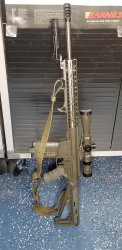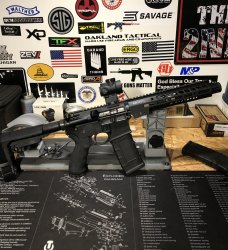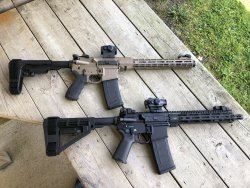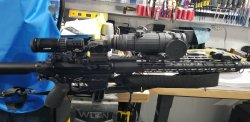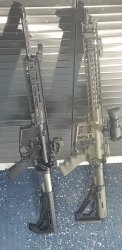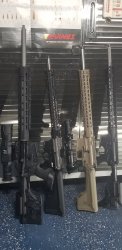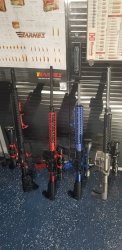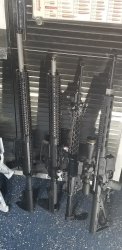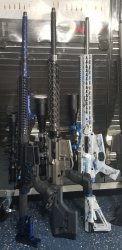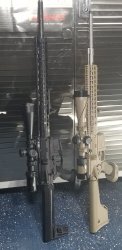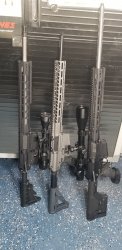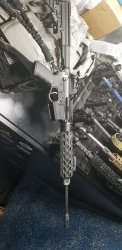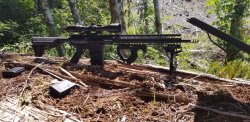testtest
You are using an out of date browser. It may not display this or other websites correctly.
You should upgrade or use an alternative browser.
You should upgrade or use an alternative browser.
Let's see your AR setups...
- Thread starter Ginge
- Start date
TEXASforLIFE
SAINT
Ginge's advice above will serve you well. Spend a bit more time researching before you start shopping, and I think you'll be happy with whatever you end up with.
In terms of the physical "body" of the modern RDS (be it of "holographic" type or the more typical reflected-LED/laser setup), don't stress too much about this. This is actually much more an aesthetic consideration (as well as one of weight), as proper technique for using unmagnified RDSs is to obtain "target focus."
Look at an appropriate target - say a light-switch - at across-room distances. With BOTH EYES OPEN, put out your thumb and cover the light switch with it while maintaining the focus of your eye on the light-switch (i.e. your target). Notice how you can see through your thumb?
This is what makes unmagnified RDSs so fast (and furthermore so appropriate for combative use, where the body's natural fight-or-flight response forces us to threat-focus), and also why it works well for folks with various eye issues, as you're literally -NOT- focused on the sight/reticle itself (this even holds true for shooters with significant astigmatism, for whom the dot will tend to appear with various artifacts/imperfections - although threat-focus will not fully eliminate the visual aberrations, it will significantly reduce it).
By visually "blowing through" the sight body, considerations such as how big the aperture is and where the switchgear/adjustment/battery compartment lies all become non-issues (or at least significantly less important issues).
Threat-focus is only one part of proper techniques for the RDS (no matter what it is mounted on, from handguns to long-guns) that is not often relayed to those who are beginners at using them. The other biggie that is often overlooked is that while the vast majority of modern RDSs are billed as "parallax-free," this is -NOT- truly the case: the truth is that this advantage of the modern RDS is dependent on your accuracy template, as explained by John Spears:
When you get that sight and you start setting-in behind it to get it zeroed, remember that you will want to exercise your fundamentals as best you can, in order to achieve the best zero that you can. Be sure that you properly cheek the rifle and that you sight through the optical center of the sight, as well as make sure that your eyepro is not causing any optical distortion.
Thanks alot . I learned a lot from this as this is going to be my first red dot on one of my gun. So far I have only had scopes on my hunting rifles.
I feel it already happen. I'm just got my Saint Victor haven't finished with the extras yet and I'm thinking about getting the Saint pistol.Adam, theres a pretty good chance you’re going to get hooked!
Ginge
Elite
Yes!I feel it already happen. I'm just got my Saint Victor haven't finished with the extras yet and I'm thinking about getting the Saint pistol.
TEXASforLIFE
SAINT
TEXASforLIFE
SAINT
All but 2 I built.
Looking for any and all advice I can find on do's and don'ts . And any info on extras for the ARs what works and what doesn't.
Best places to start are:
^ That's the late Pat Rogers' final lecture, which provides an excellent foundation to build upon. He's an excellent lecturer, so grab a light snack and something to wash it down with - the hour goes by quite fast.
From there, currently, I would say that The School of the American Rifle website/blog, YouTube Channel, and Facebook Group would be a great place to start your initial dive into the pool. https://www.schooloftheamericanrifle.com , https://www.youtube.com/channel/UCaUOYvlDrZh5LWILrVDUM4w/videos , and https://www.facebook.com/SchooloftheAmericanRifle/ and https://www.facebook.com/groups/sotar/?ref=nf_target&fref=nf This resource will get you thinking along the right lines.
As you start understanding that there's more to lowers than "a lower is just a lower" and start seeing a larger section of the sky than just what's outside your window, you'll want to prep a meal (or two) and plop down in front of your monitor/tablet/phone for this sit-in party:
^ This is a monster of a P&S (Primary & Secondary) Modcast and really starts the deep-dive. It is a great compliment to the in-depth information that you start to see (and sometimes try to climb out of!) with the SOTAR stuff that I listed above.
If you really like doing homework and are willing to do a bit of digging, the M4Carbine.net and P&S Forums both have a much higher signal-to-noise ratio than AR15.com, and are immense resources for the platform. For starters, I'd join M4Carbine.net if you haven't, and once there, start searching for the membername Iraqgunz. That's the screen-name of the late Will Larson, the man behind Semper Paratus Arms (old FB page here: https://www.facebook.com/SemperParatusArms/ - it's also chocked-full of excellent information; I'd also encourage you to simply Google search for the terms "youtube semper paratus arms"), who passed away last summer. His open-enrollment armorer's courses were a staple of the hobbyist community and professionals alike, and his old posts on M4C contain so much wisdom and experience to siphon off.
The ARBuildJunkie website is also a good place to get some background information. I haven't been on their Forums, but their interviews, Buyer's Guides, and How-Tos all seem to be on-point.
Finally, consider signing up for an AR-specific training class. Typically, beginner/novice classes of even the "run your gun" (aka "weapon manipulation") type will feature at least a morning's worth of fundamental mechanical knowledge that can often contain more than what the average hobbyist/owner knows. Even moreso, there are now more and more open-enrollment "armorer's classes" specific to the AR15 platform: anything from a multi-day class that gets into the real nitty-gritty to just a single-day's quickie that hits much more in-depth than just a basic breakdown/knowledge (like what's typically found in the morning/first-day sessions of the weapon manipulations classes) can make you so much more knowledgeable - helping you not only better maintain your weapon, but also giving you the knowledge and skills necessary to do everything from effecting *proper* upgrades/modifications and remediation of existing problems all the way to helping you become a better operator of the system (as understanding the mechanics of the gun's inner workings will help you better diagnose stoppages on-the-fly, while shooting).
Years ago, I attended a one-day "armorer's course" designed for hobbyist owners/shooters, hosted by Weyer Tactical here in NE-Ohio. The class was taught by Dave Laubert (of Defensive Creations), who is a member of the American Pistolsmith's Guild. Although an "informal" class, each student still got to tear down their ARs all the way down to individual components and then rebuilding from the ground up, remediating any problems and/or making upgrades/updates along the way while also pointing out to us what each part should be (in a not-over-the-top, let's gauge everything manner, but rather, in a more relaxed, "hobbyist" manner), and why it should be what it should be. At the end of the class, he brought out a slide show that was compiled during his years with Pat Rogers (much of the AR folks in my area are disciples of Pat or, like me, have been taught in-turn by those disciples) which documented numerous stoppages and failures - from the commonplace to the rare/unique - and discussed with us what the cause(s) was/were, and how to remediate for each. I can't even begin to express how much I learned from those 8 hours in the classroom, and ever since then, I'd wanted to take a multi-day, true-armorer-level course (I'll likely hit up SOTAR next calendar year).
Hope this helps!
The class backup/spare -

Purchased in the summer of 2011, this was my first AR. After attending one class with it (albeit not in its current configuration), I was both hooked and realized that as in many sporting endeavors, weight is the enemy - no matter how solid that gun feels.
After a few thousand rounds, this gun, a DI LMT MRP CQB 16, is now permanently my class/training backup. It rides on the other side of the flap in my main rifle bag, and it's always shot a few times and re-lubed before each class.
Aside from some personal-preference accessories and furniture, it hasn't seen much modification. The monolithic rail makes it so that I'm not very tempted to pull it off, so the upper is pretty much as it comes from the LMT factory, decorated with the two-piece Magpul XTM panels so often seen during that time period, and, of-course, with a Radian CH. Factory birdcage on the muzzle.
The lower carries my usual user-preference modifications: BCM Mod3 grip, Battle Arms Development ambi safety, Troy ambi mag release offset on the other side by a Battle Arms Development button. The POF enhanced bolt-catch still remains on this gun: I'll get around to it one of these days, but it's not a deal-breaker for me, as I've used the POF for so long. The stock is a factory LMT SOPMOD, and its weight helps balance out this piggy carbine a bit. There is a BCM Q/D endplate on the back of that lower, though, which I added for that extra Q/D slot.
The LMT factory detachable fixed front was paired with an old C-MORE Tactical (Aluminum) that I carried-over from my airsoft days, but that's since been supplanted by the above Aimpoint PRO (my buddy gave me a sweet deal on it when he upgraded to a T2) backed by a Vortex VMX-3T magifier (the magnifier appears to not be centered to the Aimpoint in this picture, and that's because I actually had it swung out to the side, so there's a bit of perspective issue at play, here ).
).
A Surefire 600 Scout w/2x CR123s on a Gear Sector offset mount (usual SR07 tape and wire management by Larue Index Clips) a couple of GearSector handstops and their shorty vert plus Q/D swivels with a VTAC (wide, upgraded) sling used to complete this rifle, which weighed-in at a rather porky 9.265 lbs (just over 9 lbs, 4 oz.) with the old C-More.
The current trade-off of a Malkoff E2HT retrofit housed in their VME head, a 16650 battery, a switch to a padded Vickers sling, and adding a rear Magpul MBUS likely makes everything even-Steven, even after dropping a couple of ounces by ditching the redundant handstops. But that magnifier is nearly 12 ounces in and of itself, and the PRO with its factory mount adds yet another 12. In-contrast, the C-More was only half that weight, so this rifle is, as-configured, actually an 11-lb. monster.
Running around for a day with it is OK, but it gets anchor-like with multi-day classes - hence my move to the DD M4V5LW, back in post #71 (https://www.thearmorylife.com/forum/threads/lets-see-your-ar-setups.258/page-4#post-4251)
Purchased in the summer of 2011, this was my first AR. After attending one class with it (albeit not in its current configuration), I was both hooked and realized that as in many sporting endeavors, weight is the enemy - no matter how solid that gun feels.
After a few thousand rounds, this gun, a DI LMT MRP CQB 16, is now permanently my class/training backup. It rides on the other side of the flap in my main rifle bag, and it's always shot a few times and re-lubed before each class.
Aside from some personal-preference accessories and furniture, it hasn't seen much modification. The monolithic rail makes it so that I'm not very tempted to pull it off, so the upper is pretty much as it comes from the LMT factory, decorated with the two-piece Magpul XTM panels so often seen during that time period, and, of-course, with a Radian CH. Factory birdcage on the muzzle.
The lower carries my usual user-preference modifications: BCM Mod3 grip, Battle Arms Development ambi safety, Troy ambi mag release offset on the other side by a Battle Arms Development button. The POF enhanced bolt-catch still remains on this gun: I'll get around to it one of these days, but it's not a deal-breaker for me, as I've used the POF for so long. The stock is a factory LMT SOPMOD, and its weight helps balance out this piggy carbine a bit. There is a BCM Q/D endplate on the back of that lower, though, which I added for that extra Q/D slot.
The LMT factory detachable fixed front was paired with an old C-MORE Tactical (Aluminum) that I carried-over from my airsoft days, but that's since been supplanted by the above Aimpoint PRO (my buddy gave me a sweet deal on it when he upgraded to a T2) backed by a Vortex VMX-3T magifier (the magnifier appears to not be centered to the Aimpoint in this picture, and that's because I actually had it swung out to the side, so there's a bit of perspective issue at play, here
A Surefire 600 Scout w/2x CR123s on a Gear Sector offset mount (usual SR07 tape and wire management by Larue Index Clips) a couple of GearSector handstops and their shorty vert plus Q/D swivels with a VTAC (wide, upgraded) sling used to complete this rifle, which weighed-in at a rather porky 9.265 lbs (just over 9 lbs, 4 oz.) with the old C-More.
The current trade-off of a Malkoff E2HT retrofit housed in their VME head, a 16650 battery, a switch to a padded Vickers sling, and adding a rear Magpul MBUS likely makes everything even-Steven, even after dropping a couple of ounces by ditching the redundant handstops. But that magnifier is nearly 12 ounces in and of itself, and the PRO with its factory mount adds yet another 12. In-contrast, the C-More was only half that weight, so this rifle is, as-configured, actually an 11-lb. monster.
Running around for a day with it is OK, but it gets anchor-like with multi-day classes - hence my move to the DD M4V5LW, back in post #71 (https://www.thearmorylife.com/forum/threads/lets-see-your-ar-setups.258/page-4#post-4251)
TEXASforLIFE
SAINT
4# 2oz as is and my largest grouping was 1.5" after 500 rounds of fast fire. It was the second 1 I built.
TEXASforLIFE
SAINT
Unfortunately, this is my last one, at least for the time being.  I really want a Knights to sorta cap-off my small collection, but I'm having a hard time finding one at a LGS to fondle before I buy (and no, I don't mind if I pay slightly more than Internet order).....
I really want a Knights to sorta cap-off my small collection, but I'm having a hard time finding one at a LGS to fondle before I buy (and no, I don't mind if I pay slightly more than Internet order).....
Anyway:

You'll recognize immediately that this rifle rolls with the old C-More Tactical that I wrote of above.
The base platform was an Aero Precision complete Midlength AC-15. It was on-sale for $600, shipped (list is usually around $700, but if you want one, wait for their sales - https://www.brownells.com/rifle-par...d-length-rifle-sku100018610-82606-176502.aspx - I've never seen it quite as low again, but I'm sure things will come around, given today's highly competitive AR market), and I had really wanted a gun specifically to go to my scheduled armorer's class with.
The base gun comes with typical standard furniture (as-pictured in the Brownells link above), but I went ahead and swapped things out with some of Magpul's "Stealth Gray" in their SL-line. The gun is a middy, of-course, so the handguard is a bit longer, and I was able to incorporate both a take-off Magpul stubby that my buddy gave me as well as my usual small section of 6-o'clock pic rail for bipod/zeroing use. FWIW, I *_really_* like the SL-stock, anyone in the market for a new stock, I'd highly recommend that you check it out in-person, as it should be readily available in most LGSs, both big and small.
The sling is the Ares Armor Husky Amentum slider that I'd written about earlier. I really loved this sling: it was comfortably padded and the slide was both simple and speedy (and just look at that awesome Kryptek Typhoon). Unfortunately, during extended use (I took one 2-day class with this sling), the slider started binding as the sling material began to double-up on itself. So, it's on the hobby gun it goes! The front is a simple MLok Q/D cup, and I have the rear going to the off side of the stock, as-usual, but this time, on the receiver, I chose to use Magpul's new-style ASAP QD Sling Plate instead of my usual BCM.... Fellow members and readers, unless you specifically want this plate for some reason, you'll want to go another route, as this nitrided piece is *really* hard to stake!
Light is again a Surefire 600-series Scout, this time set up with direct access, so its on the left, cantilevered forward using an IWC SMC that my buddy generously gifted me when he updated the rail on his Colt.
My typical preference for the Radian CH carried through to this gun as well. Safety this time is a Radian ambi, which I actually like a lot. Usual Troy-ambi release/Battle Arms Development magazine button combo, as well as the POF enhanced bolt catch. Trigger is an ALG ACT, and I also replaced the trigger guard with a Magpul, again gifted by my buddy when he upgraded his.
No weight on this guy. It's purely for fun, so I didn't even bother. Noticeably lighter than that pig of an LMT, though!
Noticeably lighter than that pig of an LMT, though!

And seriously, in today's highly contested market, I don't think I would have bought this gun. At the time, it really was a quality buy (the gun did very well in the armorer class), on-the-cheap. Today, though, with items like the SOLGW Loyal 9 and Patrol SL coming in at the $1K mark - with similar offerings from Sionics - compare that by adding up what I've put into this gun (~$100 for furniture and another $50 for the charging handle, and you're looking at a gun that would be close to $900 when not on-sale), that's a very, very hard fight, given the level of QA/QC that both SOLGW and Sionics puts into their completes.
What a difference a few years make, huh?
Anyway:
You'll recognize immediately that this rifle rolls with the old C-More Tactical that I wrote of above.
The base platform was an Aero Precision complete Midlength AC-15. It was on-sale for $600, shipped (list is usually around $700, but if you want one, wait for their sales - https://www.brownells.com/rifle-par...d-length-rifle-sku100018610-82606-176502.aspx - I've never seen it quite as low again, but I'm sure things will come around, given today's highly competitive AR market), and I had really wanted a gun specifically to go to my scheduled armorer's class with.
The base gun comes with typical standard furniture (as-pictured in the Brownells link above), but I went ahead and swapped things out with some of Magpul's "Stealth Gray" in their SL-line. The gun is a middy, of-course, so the handguard is a bit longer, and I was able to incorporate both a take-off Magpul stubby that my buddy gave me as well as my usual small section of 6-o'clock pic rail for bipod/zeroing use. FWIW, I *_really_* like the SL-stock, anyone in the market for a new stock, I'd highly recommend that you check it out in-person, as it should be readily available in most LGSs, both big and small.
The sling is the Ares Armor Husky Amentum slider that I'd written about earlier. I really loved this sling: it was comfortably padded and the slide was both simple and speedy (and just look at that awesome Kryptek Typhoon). Unfortunately, during extended use (I took one 2-day class with this sling), the slider started binding as the sling material began to double-up on itself. So, it's on the hobby gun it goes! The front is a simple MLok Q/D cup, and I have the rear going to the off side of the stock, as-usual, but this time, on the receiver, I chose to use Magpul's new-style ASAP QD Sling Plate instead of my usual BCM.... Fellow members and readers, unless you specifically want this plate for some reason, you'll want to go another route, as this nitrided piece is *really* hard to stake!
Light is again a Surefire 600-series Scout, this time set up with direct access, so its on the left, cantilevered forward using an IWC SMC that my buddy generously gifted me when he updated the rail on his Colt.
My typical preference for the Radian CH carried through to this gun as well. Safety this time is a Radian ambi, which I actually like a lot. Usual Troy-ambi release/Battle Arms Development magazine button combo, as well as the POF enhanced bolt catch. Trigger is an ALG ACT, and I also replaced the trigger guard with a Magpul, again gifted by my buddy when he upgraded his.
No weight on this guy. It's purely for fun, so I didn't even bother.
And seriously, in today's highly contested market, I don't think I would have bought this gun. At the time, it really was a quality buy (the gun did very well in the armorer class), on-the-cheap. Today, though, with items like the SOLGW Loyal 9 and Patrol SL coming in at the $1K mark - with similar offerings from Sionics - compare that by adding up what I've put into this gun (~$100 for furniture and another $50 for the charging handle, and you're looking at a gun that would be close to $900 when not on-sale), that's a very, very hard fight, given the level of QA/QC that both SOLGW and Sionics puts into their completes.
What a difference a few years make, huh?
Last edited:
Which one would you like to see?

Best places to start are:
^ That's the late Pat Rogers' final lecture, which provides an excellent foundation to build upon. He's an excellent lecturer, so grab a light snack and something to wash it down with - the hour goes by quite fast.
From there, currently, I would say that The School of the American Rifle website/blog, YouTube Channel, and Facebook Group would be a great place to start your initial dive into the pool. https://www.schooloftheamericanrifle.com , https://www.youtube.com/channel/UCaUOYvlDrZh5LWILrVDUM4w/videos , and https://www.facebook.com/SchooloftheAmericanRifle/ and https://www.facebook.com/groups/sotar/?ref=nf_target&fref=nf This resource will get you thinking along the right lines.
As you start understanding that there's more to lowers than "a lower is just a lower" and start seeing a larger section of the sky than just what's outside your window, you'll want to prep a meal (or two) and plop down in front of your monitor/tablet/phone for this sit-in party:
^ This is a monster of a P&S (Primary & Secondary) Modcast and really starts the deep-dive. It is a great compliment to the in-depth information that you start to see (and sometimes try to climb out of!) with the SOTAR stuff that I listed above.
If you really like doing homework and are willing to do a bit of digging, the M4Carbine.net and P&S Forums both have a much higher signal-to-noise ratio than AR15.com, and are immense resources for the platform. For starters, I'd join M4Carbine.net if you haven't, and once there, start searching for the membername Iraqgunz. That's the screen-name of the late Will Larson, the man behind Semper Paratus Arms (old FB page here: https://www.facebook.com/SemperParatusArms/ - it's also chocked-full of excellent information; I'd also encourage you to simply Google search for the terms "youtube semper paratus arms"), who passed away last summer. His open-enrollment armorer's courses were a staple of the hobbyist community and professionals alike, and his old posts on M4C contain so much wisdom and experience to siphon off.
The ARBuildJunkie website is also a good place to get some background information. I haven't been on their Forums, but their interviews, Buyer's Guides, and How-Tos all seem to be on-point.
Finally, consider signing up for an AR-specific training class. Typically, beginner/novice classes of even the "run your gun" (aka "weapon manipulation") type will feature at least a morning's worth of fundamental mechanical knowledge that can often contain more than what the average hobbyist/owner knows. Even moreso, there are now more and more open-enrollment "armorer's classes" specific to the AR15 platform: anything from a multi-day class that gets into the real nitty-gritty to just a single-day's quickie that hits much more in-depth than just a basic breakdown/knowledge (like what's typically found in the morning/first-day sessions of the weapon manipulations classes) can make you so much more knowledgeable - helping you not only better maintain your weapon, but also giving you the knowledge and skills necessary to do everything from effecting *proper* upgrades/modifications and remediation of existing problems all the way to helping you become a better operator of the system (as understanding the mechanics of the gun's inner workings will help you better diagnose stoppages on-the-fly, while shooting).
Years ago, I attended a one-day "armorer's course" designed for hobbyist owners/shooters, hosted by Weyer Tactical here in NE-Ohio. The class was taught by Dave Laubert (of Defensive Creations), who is a member of the American Pistolsmith's Guild. Although an "informal" class, each student still got to tear down their ARs all the way down to individual components and then rebuilding from the ground up, remediating any problems and/or making upgrades/updates along the way while also pointing out to us what each part should be (in a not-over-the-top, let's gauge everything manner, but rather, in a more relaxed, "hobbyist" manner), and why it should be what it should be. At the end of the class, he brought out a slide show that was compiled during his years with Pat Rogers (much of the AR folks in my area are disciples of Pat or, like me, have been taught in-turn by those disciples) which documented numerous stoppages and failures - from the commonplace to the rare/unique - and discussed with us what the cause(s) was/were, and how to remediate for each. I can't even begin to express how much I learned from those 8 hours in the classroom, and ever since then, I'd wanted to take a multi-day, true-armorer-level course (I'll likely hit up SOTAR next calendar year).
Hope this helps!
Thanks again. Have been watch some videos.

